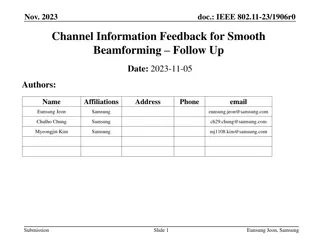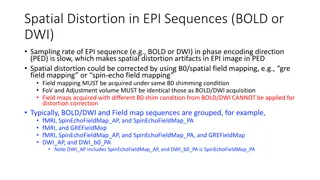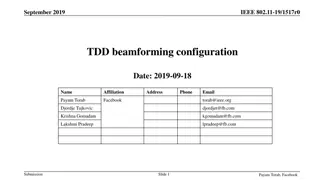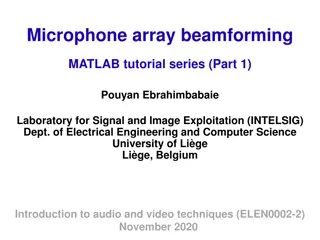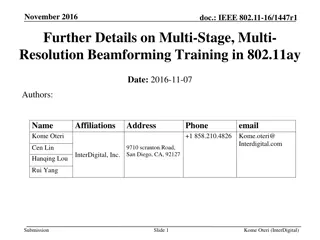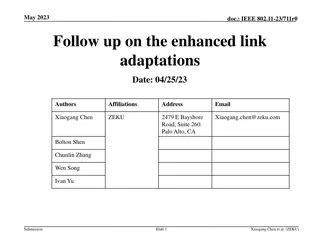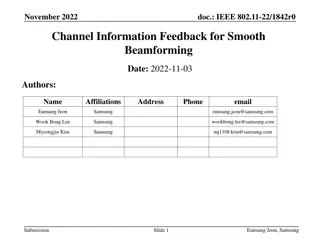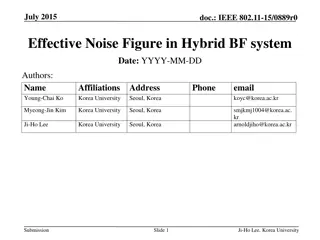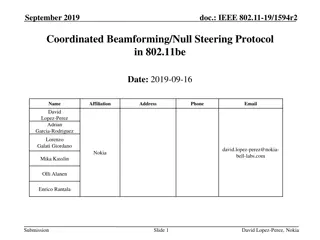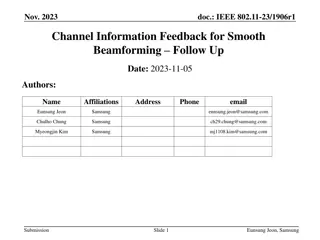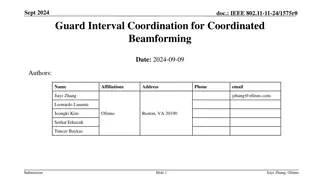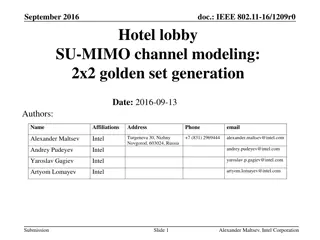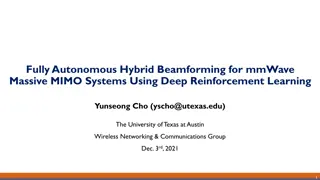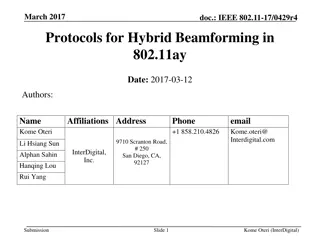
IEEE 802.11-24 Distributed RU Distortion & Beamforming Study
Explore the performance impact of nonlinear transmitter and receiver distortion in Distributed RU systems, focusing on methods to mitigate negative effects through proper tone plan design and power control. Importance of beamforming for overall performance discussed.
Download Presentation

Please find below an Image/Link to download the presentation.
The content on the website is provided AS IS for your information and personal use only. It may not be sold, licensed, or shared on other websites without obtaining consent from the author. If you encounter any issues during the download, it is possible that the publisher has removed the file from their server.
You are allowed to download the files provided on this website for personal or commercial use, subject to the condition that they are used lawfully. All files are the property of their respective owners.
The content on the website is provided AS IS for your information and personal use only. It may not be sold, licensed, or shared on other websites without obtaining consent from the author.
E N D
Presentation Transcript
November 2024 doc.: IEEE 802.11-24/1778r0 Distributed RU Distortion, Beamforming, Power Control Date: 08-November-24 Name Rainer Strobel Affiliations MaxLinear email rstrobel@maxlinear.com Sigurd Schelstraete Submission Slide 1 Rainer Strobel, MaxLinear
November 2024 doc.: IEEE 802.11-24/1778r0 Introduction Distributed RU will be introduced in 802.11bn The goal is to improve uplink OFDMA performance [1] in the 6 GHz band by overcoming the -1dBm/MHz PSD limit at low to medium SNR (not interference or TX EVM limited) Previous contributions evaluated the performance impact of CFO[2 ,3], smoothing in [4, 5] and PAPR [6] This contribution This contribution focuses on the performance impact of nonlinear transmitter and receiver distortion in DRU and methods reduce negative performance impacts by Proper tone plan design Power control In addition, the importance of beamforming for the overall performance is discussed Submission Slide 2 Rainer Strobel, MaxLinear
November 2024 doc.: IEEE 802.11-24/1778r0 Transmitter and Receiver Distortion DRU OFDMA DRU Transmitter Distortion In regular OFDMA, TX distortion mainly affects neighboring channels In distributed RUs, transmitter distortion affects all RUs The TX EVM requirements currently depend on the mcs used (e.g., Table 36- 65 in 802.11be): MCS TX EVM 0 -13 1 -13 2 -13 3 -16 4 -19 5 -22 6 -25 7 -27 8 -30 9 -32 10 -35 11 -35 12 -38 13 -38 But low TX EVM will impact other STAs in the dRU OFDMA group Submission Slide 3 Rainer Strobel, MaxLinear
November 2024 doc.: IEEE 802.11-24/1778r0 Unused Tone Error (Spec) Unused tone error For a regular RU, the distortion into neighboring bands is 2, 12 or 22 dB below the in-band distortion (as specified, e.g., in Table 36-65 in 802.11be) For a distributed RU, the in-band distortion will apply, unless it is specified differently. Submission Slide 4 Rainer Strobel, MaxLinear
November 2024 doc.: IEEE 802.11-24/1778r0 Residential Scenario Residential Scenario TDMA at full bandwidth vs. Trigger-based uplink OFDMA RRU and DRU 4-antenna AP, 2 antenna STAs 4 STAs simultaneous STA STA STA STA AP Submission Slide 5 Rainer Strobel, MaxLinear
November 2024 doc.: IEEE 802.11-24/1778r0 Beamforming and Trigger-Based Uplink Beamforming and Trigger-Based Uplink Transmission Distributed Rus are useful for trigger-based uplink. In a non trigger-based transmission, the distributed RU would waste a lot of spectrum, transmitting at a low rate while a large bandwidth is occupied. Long reach is an important use case and thus, 1 spatial stream transmission from a multi- antenna client is an important use case In the case of 2-antenna STAs transmitting 1 spatial streams, the beamforming gain is around 4dB To allow for a beamformed trigger-based uplink transmission, trigger-based sounding is needed (same as for uplink MU-MIMO) Define trigger-based uplink sounding Submission Slide 6 Rainer Strobel, MaxLinear
November 2024 doc.: IEEE 802.11-24/1778r0 Residential Scenario TDMA 160MHz 21dBm tx power 1 spatial stream, beamforming OFDMA RRU 15dBm tx power for 40MHz 1 spatial stream, no beamforming OFDMA DRU 21dBm tx power, no BF 6dB power boost gain, but 4dB beamforming gain lost and losses due to tx evm. Submission Slide 7 Rainer Strobel, MaxLinear
November 2024 doc.: IEEE 802.11-24/1778r0 Importance of Beamforming TDMA 160MHz 21dBm tx power 1 spatial stream, beamforming OFDMA RRU 15dBm tx power for 40MHz 1 spatial stream, no beamforming OFDMA DRU 21dBm tx power, beamforming Submission Slide 8 Rainer Strobel, MaxLinear
November 2024 doc.: IEEE 802.11-24/1778r0 Transmitter Nonlinear Distortion RRU, SNR of 8 RUs Nonlinear distortion, e.g., IP3 distortion depends on the TX spectrum For a regular RU, mainly the neighboring Rus are affected, because the spectrum of a dRU is flat within the used band Low MCS, High TX distortion Low TX distortion Submission Slide 9 Rainer Strobel, MaxLinear
November 2024 doc.: IEEE 802.11-24/1778r0 Transmitter Nonlinear Distortion Nonlinear distortion in a dRU The dRU spectrum is not flat Thus, the TX distortion is not flat Distortion impact on other Rus depends on the tone plan design Submission Slide 10 Rainer Strobel, MaxLinear
November 2024 doc.: IEEE 802.11-24/1778r0 Transmitter distortion evaluation of DRU Tone Plans 242-tone and 484-tone DRU design are fine in the proposals ([6, 7, 8]) 26-tone RU in [6] is ok 52-tone RU in [6] is not ok (example) Affected tones in RU 3 and 4 DRU2 with high distortion Submission Slide 11 Rainer Strobel, MaxLinear
November 2024 doc.: IEEE 802.11-24/1778r0 Receiver Distortion Power Back-off for DRU Arrangement: 2 STAs transmit to the AP One STA is very close, the other one is far away TX EVM according to 802.11be spec (2dB better than worst case) TX power of nearby STA is varied 40dB RX SNR Power back-off is important for high performance, especially for the weak link Slide 12 Submission Rainer Strobel, MaxLinear
November 2024 doc.: IEEE 802.11-24/1778r0 Current Power-Backoff Procedure Power back-off effectively depends on two measurments AP receiver measures receive power of each each STA to destinguish the desired rx power levels STA receiver measures the RX power to evaluate the link loss and derive the TX power that achieves the desired AP RX power level STAs usually have limited capabilities and the measurement is less accurate Submission Slide 13 Rainer Strobel, MaxLinear
November 2024 doc.: IEEE 802.11-24/1778r0 Procedure with a single Measurement The STA-side power measurement can be eliminated from the process Option 1: Signal the desired tx power (requires knowledge of the link attenuation and the tx power limitations of the STA) Option 2 (preferred): Signal the tx power delta w.r.t. the previous packet Submission Slide 14 Rainer Strobel, MaxLinear
November 2024 doc.: IEEE 802.11-24/1778r0 Conclusion and Next Steps Important aspects for efficient dRU operation: Allow beamforming by introducing triggered uplink sounding Consider nonlinear transmitter distortion in the tone plan design Re-evaluate unused tone error and TX EVM specs Improve power control accuracy to reduce performance impact of rx distortion Submission Slide 15 Rainer Strobel, MaxLinear
November 2024 doc.: IEEE 802.11-24/1778r0 References [1] Jianhan Liu et.al., UHR Feature to Overcome PSD Limitations: Distributed-Tone Resource Units , IEEE 802.11-23/0037r0, December 2022 [2] Eunsung Park et.al., CFO Impact and Pilot Design for dRU 11-23-1115-00-0 [3] Eunsung Park et.al., CFO Impact and Pilot Design for dRU Follow up IEEE 802.11-23/1447r0, September 2023 [4] Shengquan Hu et.al., Principle and Methodology for dRU Tone Plan Design IEEE 802.11-23/2021 November 2023 [5] Mahmoud Kamel et.al., Data Tones Grouping in Tone-Distributed RUs , IEEE 802.11-23/2031r2, January 2024 [6] Shengquan Hu et.al., DRU Tone Plan for 11bn IEEE 802.11-24/0468r2 May 2024 [7] Chenchen Liu et.al., Updated Proposal for 80MHz DRU Tone Plan IEEE 802.11-24/1465r1 September 2024 [8] Eunsung Park et.al., Proposal for DRU Tone Plan IEEE 802.11-24/1470r0 September 2024 Submission Slide 16 Rainer Strobel, MaxLinear
November 2024 doc.: IEEE 802.11-24/1778r0 APPENDIX Submission Slide 17 Rainer Strobel, MaxLinear
November 2024 doc.: IEEE 802.11-24/1778r0 Simulation parameters Value Parameter TX/RX Antennas 4/2 APs/STAs 1/4 Spatial streams 1 Bandwidth 160 MHz AP TX Power 21 dBm Channel model D NLOS [8] MCS 0-13 (optimized) Frequency 6.GHz GI 1.6 s TX/RX SNR As on slide8/40dB Channel aging/Doppler 1.2km/h, 6Hz BF quantization ideal Precoder type SVD-based beamforming Sounding interval 100ms Overhead Sounding and MAC overhead not considered TDMA time allocation 25% for each STA Submission Slide 18 Rainer Strobel, MaxLinear


